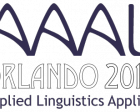You are here
APU corpus at AAAL 2016!
Our abstract proposal for the AAAL Conference has been accepted! The APU corpus will be presented at the annual conference of the American Association of Applied Linguistics in April 2016, which will take place in Orlando, Florida. You can read the abstract below.
In educational linguistics, corpus-based research on children’s writing has been spearheaded by Biber and associates since the early 1990s (Reppen 1994, 2004; Biber et al. 2007). In Britain, however, the availability of corpora for such investigations is still very limited (cf. The Lancaster Corpus of Children’s Writing; The Oxford Children’s Corpus of Reading and Writing). This is especially important if we bear in mind that some of the current debates in the UK educational domain focus on the maintenance and/or improvement of standards of writing performance (cf. Clark 2011; Clark & Douglas 2012) and that studies of children’s writing performance across time have to date reached somewhat contradictory results (Massey et al. 1996; Massey & Elliot 2006; Rashid & Brooks 2010).
The focus of this paper is methodological and the approach is twofold. Firstly, we will describe the contents and the structure of the APU Writing and Reading Corpus 1979-1988: the first historical corpus of British schoolchildren’s materials (11- and 15-year-olds). Based on the data retrieved from the Assessment of Performance Unit (Foxman et al. 1991) and in line with Reppen (1994), this corpus includes both writings by children (narrative and argumentative, as these text-types have a long-standing tradition in UK school-teaching; cf. Kress 1994, Myhill et al. 2011) and writings for children, so-called ‘basal readers’, often used as target models for writing. The corpus is morphologically and semantically tagged and will be available to users via an online interface. Secondly, we will outline a selection of case-studies on the APU Corpus and the ways in which they can contribute to current socio-cultural debates on literacy (for instance, on the general perceptions on how well standards of literacy fulfil the demands of the job market; Aronoff 1994: 68; Ravid & Tolchinksy 2002: 418).










